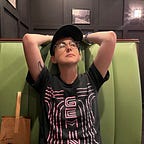Patron Saints
Joan of Arc, Pauli Murray, and the surprisingly long history of transmasculine saints.
Last year, I realized that if I want to keep learning, I’ve got to treat myself like I’m in school. I am obsessive by nature; my inclination is to keep gnawing away at one or two questions until I’ve either perfected a solution or ground the material to dust. If I want diverse interests, I have to force them. So, every month, I choose something I want to learn. I take the most relevant books from my bookshelves; if I don’t have any relevant books, I buy them. I make a little stack, my syllabus, and I work my way through it. At the end of the month, the books I haven’t finished get put away to make room for the next stack.
Recently, I’ve been studying saints. Monks, specifically; transgender monks, even more specifically, and there were more of those than you’d think. There is a long and barely hidden tradition of transmasculine sainthood within the Catholic Church, lurking just to the side of acknowledged history.
Some of this history is widely known. Lots of people know, for example, that Joan of Arc was executed for wearing men’s clothing. Leslie Feinberg loved Joan of Arc. I love Joan, too; at confirmation, Catholics have to choose a “patron saint,” someone to watch over their souls and provide spiritual guidance, and Joan…
